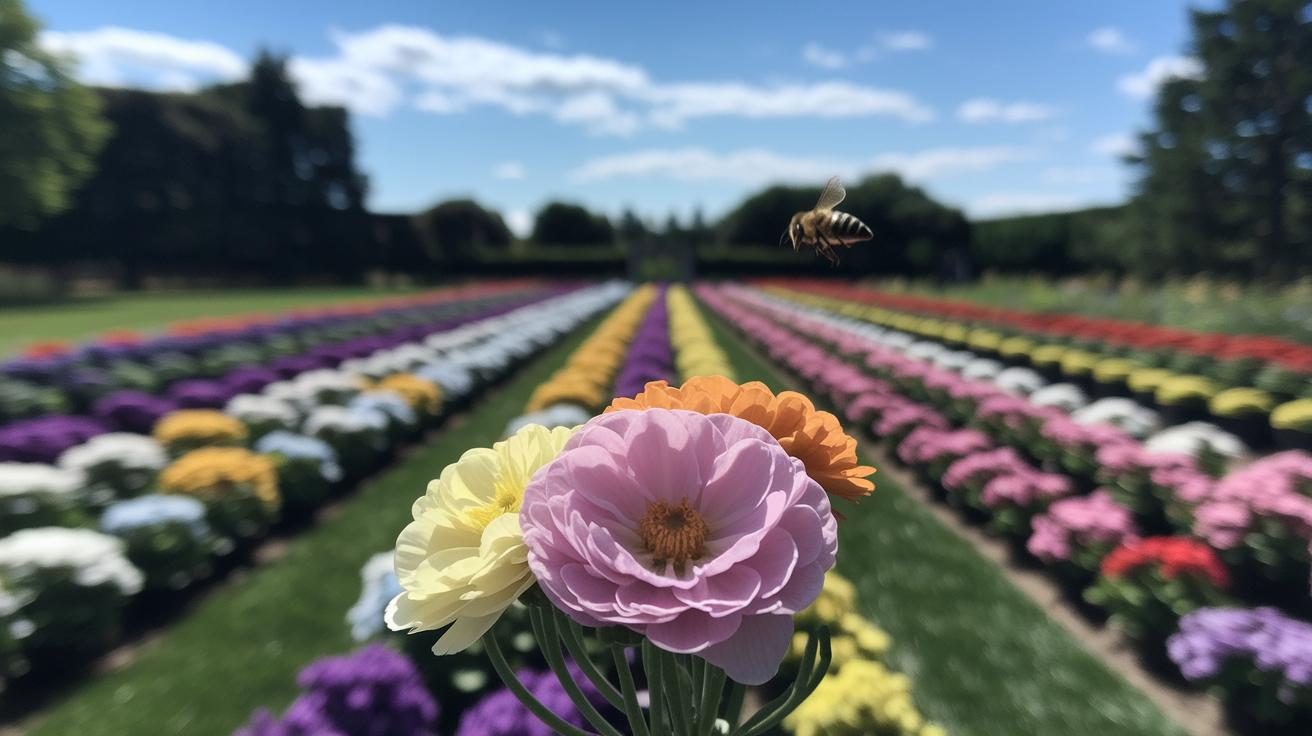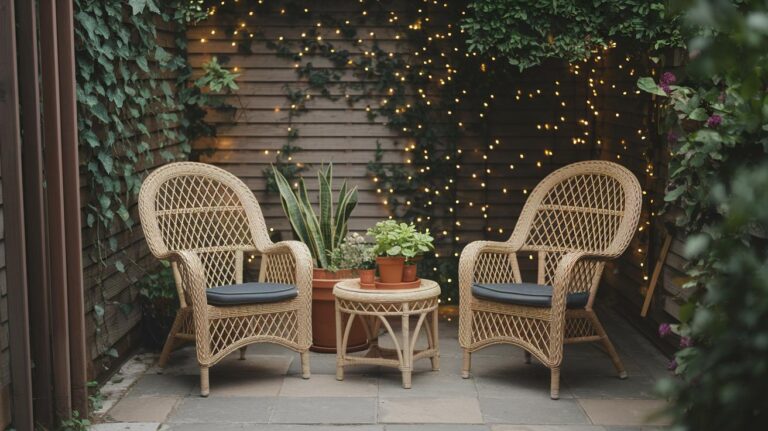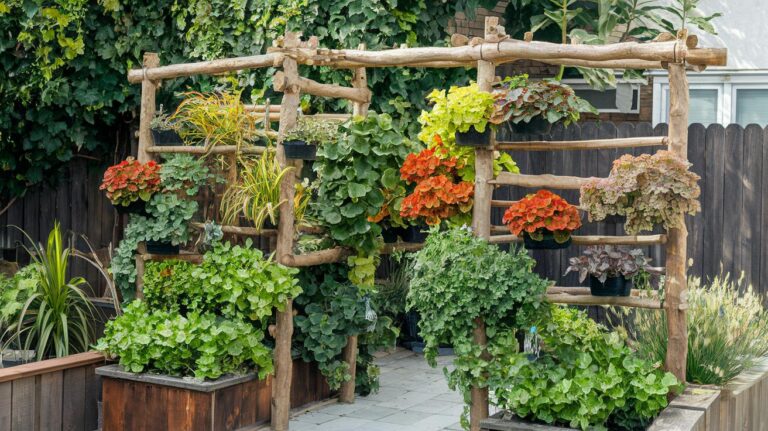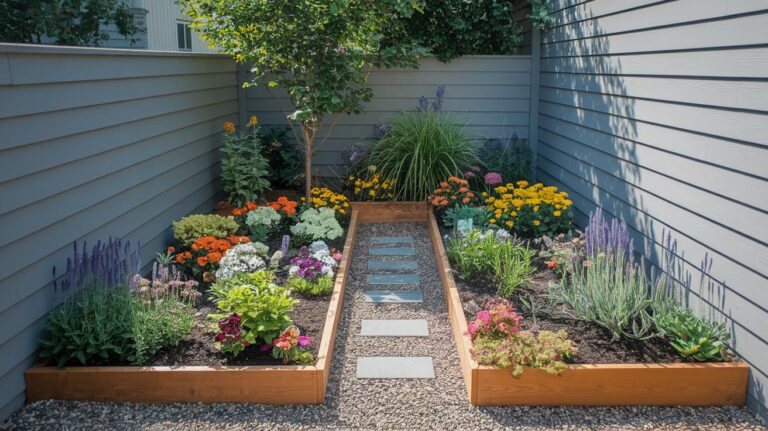DIY Pollinator Garden Layout Amazing Step-By-Step Plan
Have you ever spotted a lone flower trembling in the breeze, waiting for a friendly bee that never showed? It’s a sad sight. But you can fix it with a DIY pollinator garden layout (how you arrange plants so butterflies, bees, and hummingbirds find their snacks).
Think of your yard as a buffet for winged friends. Picture hummingbirds hovering over bright red blooms, bees buzzing around lavender, and butterflies sipping nectar from daisies. By placing each flower where it basks in sun and breathes easy, you turn your garden into a nonstop snack station. Oops, spilled a bit of potting mix there, right?
In this guide, I’ll share a simple, step-by-step plan (one step at a time). You’ll learn to sketch your garden beds on paper, mark sunny spots, and space out your plants so they don’t fight for room. Then we’ll pick native blooms (flowers that grow naturally near you) and arrange them to keep color and nectar flowing from spring until the first frost. Have you ever smelled fresh mint on an early morning breeze?
By the end, your backyard will hum with life and color. Planting now sets you up for a summer of buzzing bees and fluttering butterflies.
Blueprint for Your DIY Pollinator Garden Layout
Planning your pollinator garden is like drawing a treasure map for bees and butterflies. You’re figuring out where flowers will go, when they’ll burst into color, and how much elbow room each needs. A clear plan keeps you from crowding plants or leaving sad empty spots, and it helps you picture a full season of blooms.
-
Site Selection
Pick a spot that gets at least six hours of full sun a day. You want that warm earth cradling your flowers and early morning rays waking sleepy buds. -
Sun Mapping
Spend a day watching your chosen area. Note where the sun travels and where shade sneaks in. I like snapping a phone pic and jotting sun times right on it. -
Microclimate Assessment
Check for wind gusts, damp patches, or hot zones near walls. Microclimate (small area with its own temperature or moisture) spots tell you which plants will thrive, or struggle. -
Blueprint Drawing
Grab graph paper or open a garden-planning app. Sketch in beds, paths, and any stones or benches. Seeing curves and corners helps you tweak before you dig. -
Bloom-Time Grouping
Line up plants by bloom season, early spring, summer, fall. That way you’ll have nonstop nectar and pollen for every pollinator passing through. -
Spacing Plan
Leave about 12–24 inches between smaller flowers and up to 36 inches for big perennials (plants that live more than two years). Good airflow helps leaves dry out and keeps roots cozy.
Landscape apps with sun-tracking or drag-and-drop icons make this fun. But honestly, pencil, ruler, and eraser still work like a charm. Paper sketches let you swap shapes, shuffle colors, and plan paths before you break ground.
Selecting Native Plants and Scheduling Blooms for a Pollinator Garden Layout
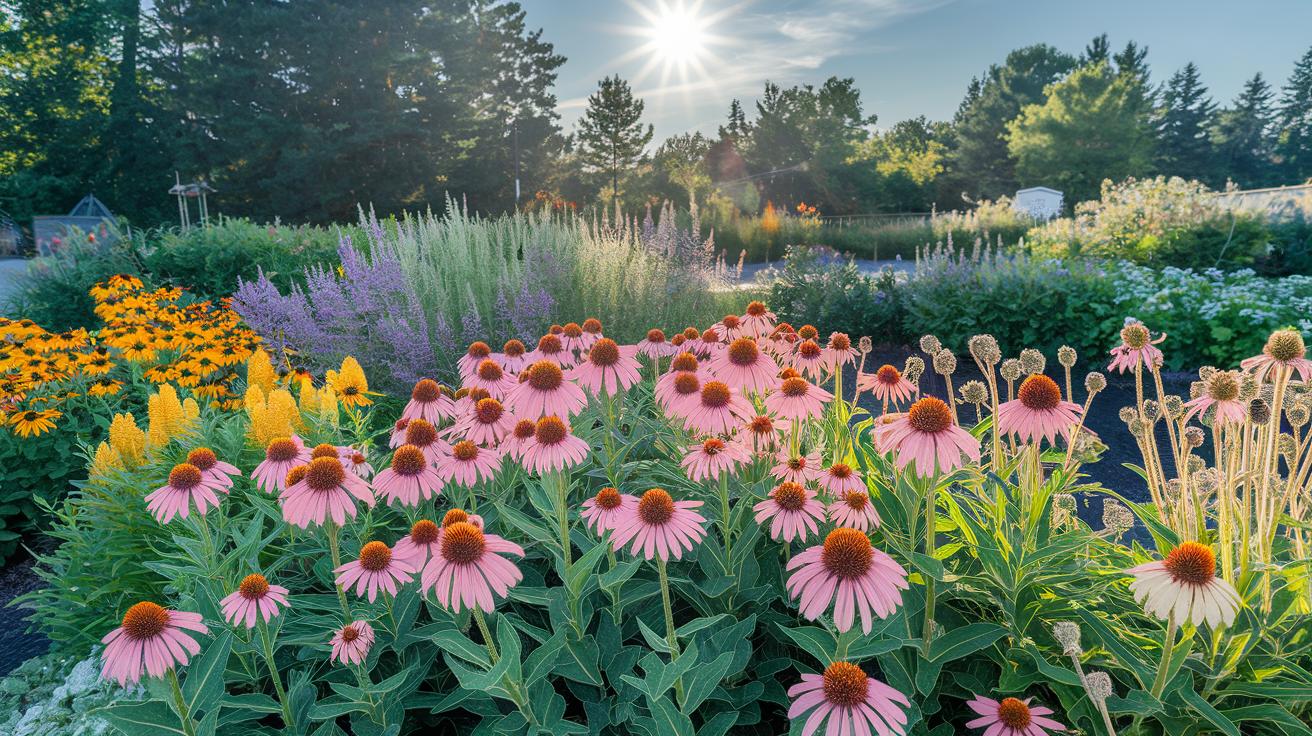
A vibrant pollinator garden starts with picking native plants that love your local soil. Map your bed so each flower gets its own spot. Plan for nonstop color by thinking about bloom times. Have you ever smelled fresh bee balm (a bright red or pink flower full of nectar) in the morning? Coneflowers and black-eyed Susans are also top picks. They’re loaded with nectar, so bees and butterflies keep coming back.
| Plant | Bloom Time | Pollinators |
|---|---|---|
| Coneflowers | Early summer to late summer | Bees, butterflies |
| Milkweed | Mid-summer | Monarch butterflies |
| Black-eyed Susans | Mid-summer to fall | Bees |
| Bee Balm | Summer | Hummingbirds, bees |
| Lavender | Summer | Bees, butterflies |
When you lay out your bed, group spring bloomers together. Then cluster summer flowers and fall stars. That way you get nectar-rich flowers all year. Try a shallow pan of water by your blooms. Thirsty visitors will swoop in for a cool sip. Group milkweed with lavender and coneflowers to show off your native plant skills. By the way, I planted shade-tolerant perennials (plants that come back every year) in my shaded corner. You can see more ideas at butterfly garden plants for shade.
Oops, I just spilled a bit of potting mix. But hey, that’s garden life.
Planting now sets you up for summer harvest.
Stand back and watch bees and butterflies dance among your blooms. Your pollinator garden will feel full and buzzing from March to November.
Preparing Soil and Building Beds in Your Pollinator Garden Layout
First, clear the garden of weeds, old roots, and stones so your flowers start in fresh earth. Pull each weed by the root and dump it into the yard waste bin. Rake away rocks, sticks, and any debris until the soil feels smooth. Then poke a garden fork or shovel into the ground to break up stubborn clumps.
Next, fold in a two-inch layer of compost (decayed organic matter that feeds plants). It’s like giving your soil a vitamin shot so your pollinators get all the sweet nectar they need. Stir the soil down to about six inches so roots can stretch out and grow. Oops, I sometimes spill a bit extra compost. It still works fine, trust me.
Now let’s check drainage. Pour a little water on the bed and watch how it sinks in. If you see puddles forming, sprinkle in more compost or some sand to help water seep faster. Once it drains nicely, rake the top one last time to level out low spots.
Thinking about bed styles? In-ground beds use the soil you already have for a classic look. Raised beds keep the dirt loose and save your back when you bend. If your space is tiny, try container gardening on a patio or balcony. Line beds with wooden planks or stones for neat edges. Lay down gravel or stepping stones to mark a sweet path. And set out a shallow dish of water so thirsty bees can sip safely.
Finally, top everything with a two-inch layer of mulch. I like wood chips, straw, or leaf litter. Mulch locks in moisture and slows those pesky weeds from popping up.
Planting now sets you up for a summer full of fluttering wings and bright blooms. Have you ever felt the soft hum of bees around lavender? That’s the best sign you’re nailing your pollinator paradise.
Arranging Plants and Companion Strategies in a Pollinator Garden Layout
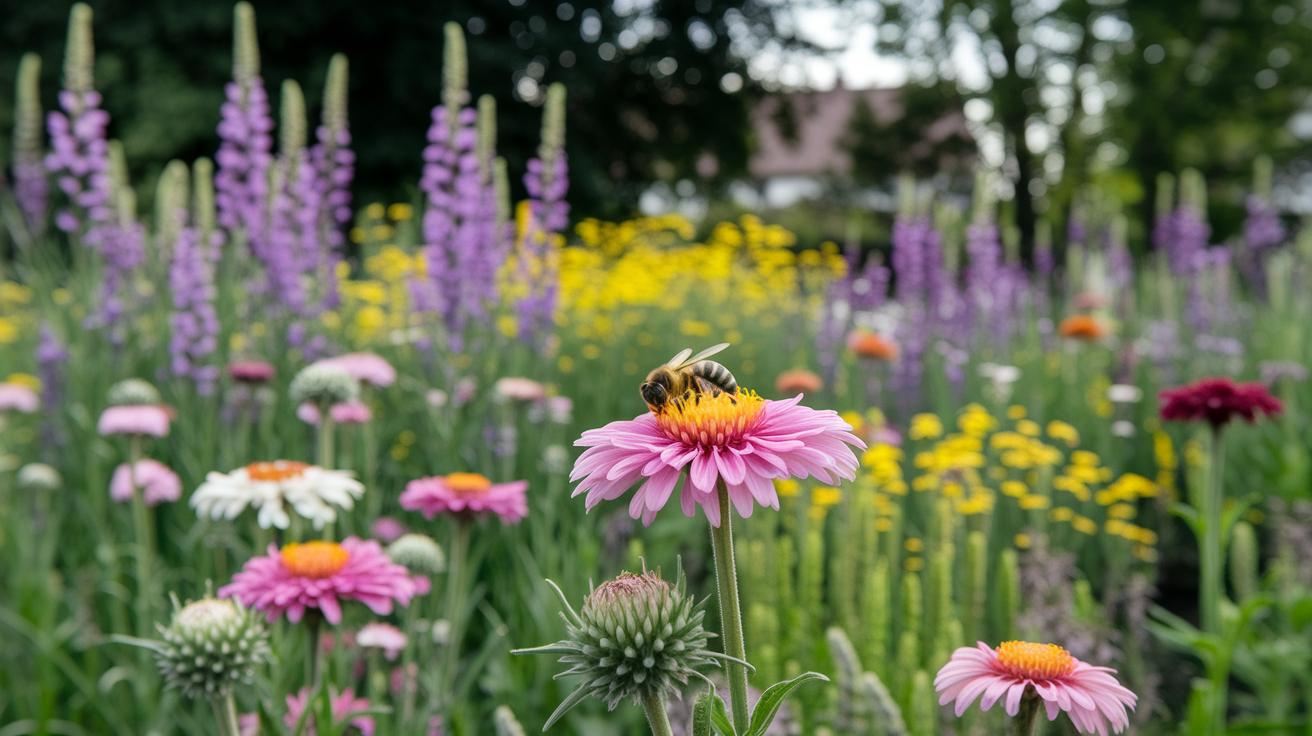
Giving each bloom plenty of space keeps leaves lush and roots happy. Think of your flowers stretching out, not bumping elbows.
Have you ever felt the warm sun on your face while you tuck in new seedlings? It’s a small joy in the garden.
- Smaller blooms like alyssum (tiny trailing flowers) or pansies need about 12 to 18 inches between them. They love elbow room.
- Medium perennials (plants that come back each year) such as salvia or bee balm do best with 18 to 24 inches of wiggle room.
- Taller perennials like hollyhocks or sunflowers deserve up to 36 inches, those big roots need to spread.
- Stagger your rows instead of lining them up perfectly straight. Air moves more freely and keeps leaves from getting soggy.
- Edge each planting zone with stones or timber borders. It shows where one group of plants ends and the next begins.
Mix in companion planting to bring more pollinators buzzing.
- Plant tubular flowers, like cardinal flower or trumpet vine, near feeders. Hummingbirds can’t resist their shape.
- Group flat-topped blooms, daisies and coneflowers, where butterflies can land like it’s an open café.
- Choose a color scheme: cool blues and purples beside warm reds and yellows guide bees and butterflies visually.
- Plan your bloom sequence: start with crocus and lungwort in spring, move to bee balm in summer, then finish with asters in fall.
- Layer heights: creeping thyme at the front, monarda in the middle, and tall verbena at the back gives a tiered look.
By the way, don’t forget vertical options like trellises or living walls. They add height and save ground space.
Oops, spilled some potting mix there. Back to prepping your soil, the garden’s waiting!
Incorporating Pollinator Amenities in a DIY Garden Layout
Want more bees, butterflies, and hummingbirds? Think beyond blossoms. Tiny water spots, cozy hideaways, and simple nests turn your yard into a pollinator paradise. Ready to dig in?
- Shallow water dish (low saucer for sipping): Pop a dish in a half-sunny corner. Tuck in smooth pebbles so bees and butterflies can land without slipping and sip cool droplets.
- Hummingbird feeder spot (small sugar-water feeder): Hang a little feeder near bright blooms (see hummingbird garden design ideas). Slip it under leafy branches so hummingbirds feel safe while they dart and hover.
- Bare-soil patch (open dirt area for ground-nesting bees): Clear grass and weeds in a sunny spot. Rake the soil smooth, leave gentle slopes, and promise not to step there, ground-nesting bees will thank you.
- Insect hotel (shelter for bugs to rest and nest): Bundle bamboo tubes (hollow sticks), pine cones, and small logs inside a weatherproof box. Mount it at chest height on a post or fence, your backyard “hotel” will buzz with life.
- Wildlife mulch (two-inch layer of wood chips or straw): Spread it around your plants. It holds moisture like a sponge, keeps weeds at bay, and offers hiding spots for tiny ground dwellers.
A little bird bath or bug condo tucked by your flowers instantly feels welcoming. Mix pretty touches with practical needs, and your garden will hum with happy visitors. Watch them linger, you might catch a butterfly pause on a peony petal.
Maintaining Your DIY Pollinator Garden Layout Throughout the Seasons

I set up a quick garden check-in every week so thirsty blooms don’t dry out. I swap between gentle hand-watering and a drip irrigation system (slow, steady water drop) to match each plant’s mood. It’s like a little spa day for the soil. And when the sun steals the clouds, I tap into my rain barrel (a big container that catches rainwater) for a top-off.
Here’s my simple seasonal to-do list:
- Early spring: sow nectar-rich seeds or plant young seedlings to kick-start the nectar flow
- Install drip irrigation and fill rain barrels for dry spells
- Summer: if the soil feels dry, hand-water or let those drip tubes do their thing
- Deadhead spent flowers (snip off old blooms) to invite more blossoms
- Organic pest control (eco-friendly methods): pick off bugs or spray soapy water on trouble spots
- Fall: tuck in fall-blooming perennials (plants that come back each year) for late color
- Seasonal cleanup: prune dead stems and sweep away fallen leaves
- Winter: spread straw or wood chips as mulch to lock in moisture
Look for low-care plants that shrug off heat and skip a watering now and then. I’m smitten with lavender, yarrow, and sedum, drought-tolerant species that still lure buzzing bees with sweet scents. They stand tall under the hot sun with hardly any fuss. The soft hum of wings feels like applause.
When your beds mostly care for themselves, you get more time to lean back with a cold drink and less time wrestling hoses. These tough blooms will keep your pollinator patch buzzing even when the water’s running low.
Final Words
In the action, you sketched your site, mapped sun and microclimates, drafted a plant blueprint, and picked pollinator-friendly blooms. You learned how to prep soil, build beds, space plants, and add cozy nooks like insect hotels and water stations.
Seasonal care tips will carry you from spring sowing to winter mulch. Your own diy pollinator garden layout shines with low-effort upkeep and wildlife-friendly flair. Happy gardening, you’ve got this backyard project blooming in no time!
FAQ
Frequently Asked Questions
How do I select the best site for my pollinator garden?
Selecting a site for a pollinator garden means choosing a spot with at least six hours of full sun and good soil drainage, plus easy access to water.
How do I map sun exposure and microclimate zones?
Mapping sun exposure and microclimate zones starts by noting light patterns across the day and watching temperature or wind differences, then marking zones on a simple sketch.
What’s the best way to draft a garden blueprint?
Drafting a garden blueprint begins by drawing your garden’s outline to scale on graph paper or an app, then placing plants by height and bloom timing before planting.
How do I group plants by bloom time for continuous blooms?
Grouping plants by bloom time means sorting them into early spring, summer, and fall categories so you have nectar sources from March through October in your garden.
How much space should I leave between plants?
Spacing smaller flowers 12–24 inches apart and larger perennials up to 36 inches apart lets each plant reach its mature size without crowding its neighbors.
What tools can help me sketch and plan my pollinator garden layout?
Using garden planning apps or mapping tools plus pencil and graph paper lets you tweak plant placement, measure sun exposure, and create a clear, ready-to-use layout.

